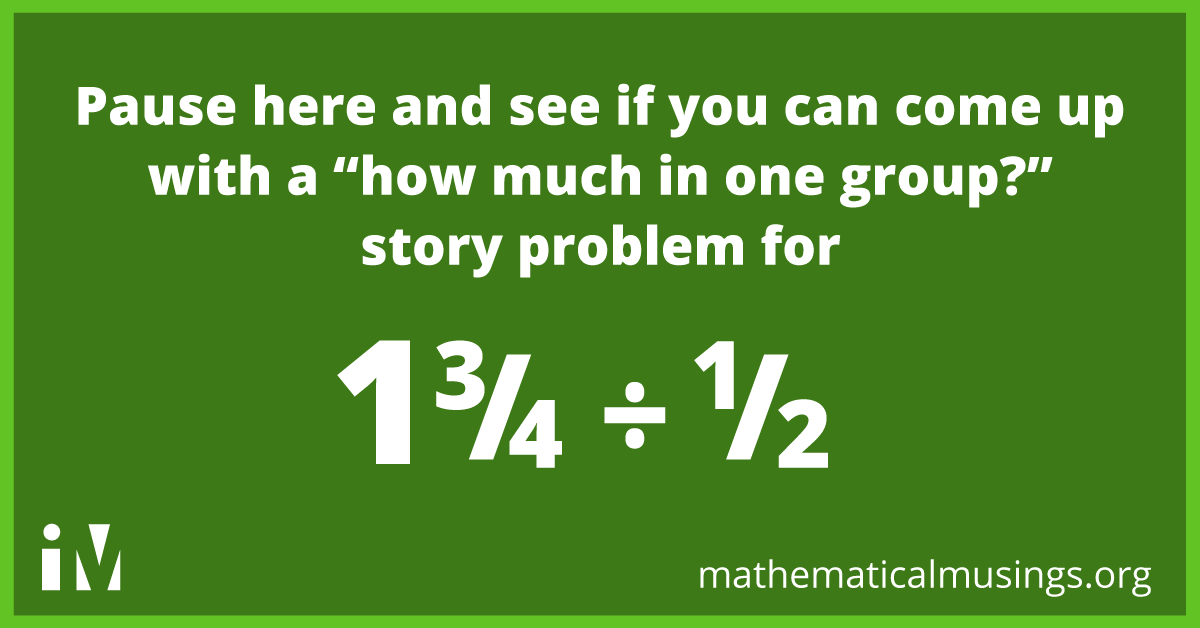By William McCallum and Kristin Umland
In her book Knowing and Teaching Elementary Mathematics, Liping Ma wrote about this question and how teachers responded to it:
Write a story problem for $1 ¾ \div ½$.
[Pause here and think about the answer yourself.]
Many people find it hard to come up with a story problem that represents fraction division (including many math teachers, engineers, and mathematicians). Why is this hard to do? For many people, their schema for dividing fractions consists almost entirely of the “invert and multiply” rule. But there is much more to thinking about fraction division than that. So much in fact, that we can’t say it all in a single blog post. This is the first of several musings about fraction division.
The trouble with English
Consider this problem:
If you have 12 liters of tea and a container holds 2 liters, how many containers can you fill?
You probably know instantly that this is a division problem and that the answer is 6, because you know your times tables, and specifically you know that $2 \times 6 = 12$. If we say that $a \times b$ means $a$ equal groups of $b$ things in group, then a division problem where $b$ and $a\times b$ are known but $a$ is unknown is called a “how many groups?” problem. Here are some other questions that ask “how many groups?”
- If you have 1 ½ liters of tea and a container holds ¼ liter, how many containers can you fill?
- If you have 1 ¼ liters of tea and a container holds ¾ liters, how many containers can you fill?
- If you have ¾ liter of tea and a container holds 1 ¼ liters, how many containers can you fill?
Some people think that the last one feels like a trick question because you can’t even fill one completely. Because we know the answer is less than one, we could also ask it this way:
- If you have ¾ liter of tea and a pitcher holds 1 ? liters, how much of a container can you fill?
So a division problem that asks “how many groups?” is structurally the same as a division problem that asks about “how much of a group?”, but because of the way we speak about quantities greater than 1 and quantities less than 1, the language makes the structure harder to see.
What other ways might we see the parallel structure?
Diagrams:
Equations: $$? \times2 = 12, \quad ? \times \frac14 = 1\frac12, \quad ? \times \frac34 = 1\frac14, \quad ? \times 1\frac14 = \frac34.$$ The diagrams don’t have the language problem. In all cases the upper and lower braces show the relation between the size of a container and the amount you have. Whether a whole number of containers can be filled (diagrams 1 and 2), a container plus a part of a container can be filled (diagram 3), or only a part of a container can be filled (diagram 4), the underlying story is the same.
Many people think of diagrams primarily as tools to solve problems. But sometimes diagrams can help students see structure or reveal other important aspects of the mathematics. This is an example of looking for and making use of structure (MP7).
The equations have an even clearer structure, but more abstract. They all have the structure $$\mbox{(quantity of containers)}\times\mbox{(size of a container)} = \mbox{(how much you have)}.$$
The intertwining of the abstraction of the equations and the concreteness of the diagrams is a good example of MP2 (reason abstractly and quantitatively).
Coming up next week: what else are diagrams good for?

